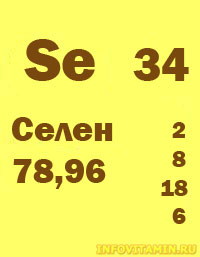Selenium — description, useful properties and application, daily allowance, food sources
Although even scientists fully appreciated the role of selenium only in 1979, this trace element is now considered one of the most important, since it helps prevent cancer and, of course, many other pathologies.
Selenium — what is it?
 Selenium. |
Selenium is a metalloid (nonmetal), the content of which in the soil depends on the region. This trace element, necessary for vital processes, is present throughout the body, but its highest concentration is in the kidneys, liver, spleen, pancreas and testes.
Useful properties of selenium
Selenium acts as a part of selenoproteins. The most famous of them are glutathione peroxidases. These antioxidant enzymes form the main line of defense against free radical attacks. Those, in turn, are continuously produced by the body itself during cellular respiration and reach especially high concentrations during acute stress and fatigue. Their excess is fraught with premature aging of all tissues, the development of degenerative pathologies, atherosclerosis and cancer. Adequate consumption of selenium is necessary to prevent all these troubles. Selenoproteins restore antioxidant activity vitamins C and E, act against free radicals in conjunction with them, participate in detoxification of the body, protecting it is protected from certain heavy metals and poisons, necessary for the regulation and modulation of inflammatory and immune processes.
The main use of selenium
Of particular interest to scientists is the role of selenium in the prevention of malignant neoplasms. Experts from Cornell and Arizona Universities in the USA, observing 1,300 people for several years, concluded that daily consumption of 200 micrograms of this trace element reduces the risk of prostate cancer by 63%, colon cancer by 58, lung cancer by 46, and in general all its incurable types by 39%. Shocked by the results, the scientists, interrupting the study ahead of schedule, recommended that participants from the placebo group replace it with selenium supplements. Selenium also shows good prospects in the prevention of other types of cancer, but the data on this subject are only preliminary and require confirmation. In addition, by stimulating the immune system, it enhances antiviral protection. This could be useful for hepatitis and some types of cancer. The potential is being studied now selenium in the fight against herpes viruses (herpes simplex and shingles) and especially against HIV.
Additional benefits
As an antioxidant, selenium certainly protects us from cardiovascular diseases, so its deficiency is especially dangerous for those who have already been diagnosed with such a diagnosis, as well as for smokers. In combination with vitamin E, it has a pronounced anti-inflammatory effect. Their combination is recommended in the treatment of chronic diseases such as rheumatoid arthritis, psoriasis, lupus and eczema. Finally, selenium helps prevent cataracts and macular degeneration of the retina.
| Latest news |
| In the laboratory, selenium acts relatively quickly: it helps cells maintain a normal rhythm of development and death, thus preventing their malignant degeneration. According to scientists, the same rapid results can be expected at the level of the whole organism. In experiments on mice, it has been shown that a deficiency of the antioxidants selenium or vitamin E can contribute to the transition of viruses from a latent, inactive form to an active one. |
Our needs: recommended daily allowance of selenium
The recommended daily intake of selenium is 75 mcg for men and 60 mcg for women (60-80 mcg starting from age 65). However, to achieve maximum effectiveness, a therapeutic dose of up to 200 mg per day may be required.
Disadvantage. The poorer the soil is with selenium, the less it is in food. Deficiency of this trace element, as follows from all of the above, simply increases the risk of cancer, coronary heart disease, viral and inflammatory diseases. Early symptoms of selenium deficiency include muscle weakness and fatigue.
Excess. If you get selenium only from food, overkill is excluded. However, if you use supplements, keep in mind: doses above 900 mcg/day lead to intoxication. Her symptoms include nervousness, depression, nausea and vomiting, garlic breath, hair loss and nail damage.
| For your information |
| One American (aka Brazilian) nut contains up to 75 mcg of selenium, i. e. its norm. There is also a lot of it in one lamb kidney — about 50 micrograms. |
Indications for the use of selenium
• Prevention of cancer and cardiovascular diseases (in combination with vitamin E).
• Prevention of cataracts and macular degeneration of the retina.
• Weakness of the immune system.
• Viral infections: herpes and shingles; slows down the development of HIV/AIDS.
• Symptoms of lupus.
Methods of application of selenium
• Doses
For long-term preventive intake, nutritionists recommend about 100-200 mcg/day.
• How to take
If you are at risk of coronary heart disease, eat foods rich in selenium and vitamin E, which act synergistically.
| Caution! |
| • If you are being treated with medications, take any medications only with the permission of a doctor. |
Release form
• Capsules
• Tablets
| Your choice |
| If you have declared war on free radicals, choose a drug that combines selenium with other powerful antioxidants, for example alpha lipoic acid, coenzyme Q10, grape seed extracts or green tea, beta-carotene, vitamins C and E. |
Food sources of selenium
The best food sources of selenium include American nuts, seafood, liver, kidneys, poultry, meat. There is also a lot of selenium in whole grains, especially oats and brown rice, but only if they grew on soil rich in this element.
To the section «Mineral substances — descriptions, properties and applications»
•••••••••
